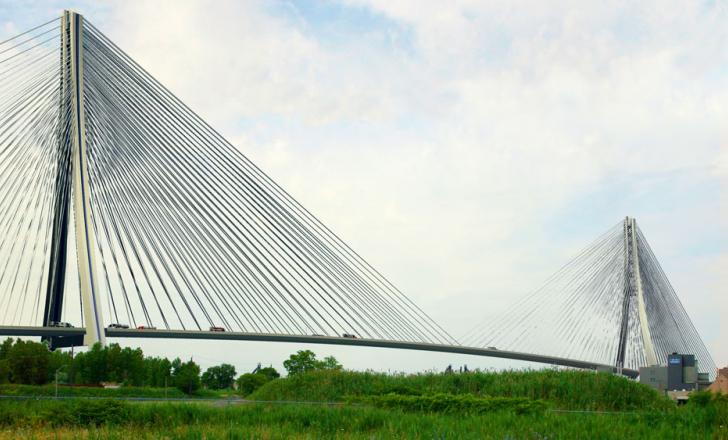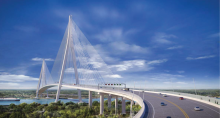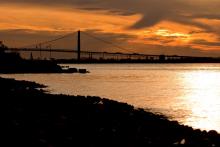The Windsor-Detroit Bridge Authority has chosen three final bidders for the six-lane Gordie Howe International Bridge to be built between the Canadian city of Windsor and Detroit in the US state of Michigan.
The estimated US$2 billion toll bridge, to be built under a public private partnership, is expected to be finished by 2020.

Artist impression, Gordie Howe Bridge (source WDBA)
The Windsor-Detroit Bridge Authority has chosen three final bidders for the six-lane Gordie Howe International Bridge to be built between the Canadian city of Windsor and Detroit in the US state of Michigan.
The estimated US$2 billion toll bridge, to be built under a public private partnership, is expected to be finished by 2020.
Among the CanAm Gateway Partners group are4138 Bechtel Canada, 1419 Arup-Hatch Mott McDonald Design and EllisDon Civil. Companies in Bridging North America include 917 ACS Infrastructure Canada, 6343 Fluor Canada and 1397 AECOM. Legacy Link Partners is led by 2482 SNC Lavalin Constructor, 3085 Vinci Construction and 1021 American Bridge Canada.
A full list of consortia partners is available on the %$Linker:2 External <?xml version="1.0" encoding="utf-16"?><dictionary /> 0 0 0 oLinkExternal website Visit website page false https://www.wdbridge.com/en/short-listed-respondents-for-the-gordie-howe-international-bridge-project false false %> of the Windsor-Detroit Bridge Authority (WDBA), a not-for-profit Canadian government corporation.
WDBA is managing the procurement process for the design, construction, financing, operation and maintenance of the Gordie Howe International Bridge between Windsor, Ontario and Detroit, Michigan through a public-private partnership (P3). The WDBA is also responsible for project oversight.
Although the bridge is economically important to the United State and Canada, it will be a totally Canadian project. Around a quarter of the annual $658 billion Canada-US trade crosses over the river. The vast majority of cross border commercial traffic now uses the 2.3km US privately owned Ambassador Bridge, whose owners have tried to stop the construction of a new bridge.
Canada is also paying an estimated $1.77 million for a US customs plaza on the American side, as well as access roads linking US freeways to the bridge.
In January last year the Windsor-Detroit Bridge Authority, set up to manage building a new bridge, appointed the Canadian arm of California-based3220 Parsons as general engineering consultant under a reportedly $17 million contract.
A Transport Canada notice in 2008 suggested two designs. A suspension bridge would have an elongated ‘M’ shape, similar to the Ambassador Bridge. A cable-stayed structure would be noticeable by its ‘A’ shape, similar to the Sunshine Skyway Bridge in Tampa, Florida. Both options would be nearly 3km long.
The suspension option would have 855m spans while a cable-stayed bridge would use 840m spans. Both bridges would have the same 40m clearance at the shorelines and have a 47m clearance at channel centre.
Main towers for the cable-stayed option would be 250m high main towers while a suspension bridge’s towers would be around 140m. Both options would have 36m wide decks for six lanes and include a median, shoulders and – security concerns aside - a walkway and/or cycle path on one side.
A Canadian customs plaza might cover around 43 hectares with 29 inbound inspection lanes, including nine for cars, 14 for trucks and five for both cars and trucks. One lane would be for buses.
The estimated US$2 billion toll bridge, to be built under a public private partnership, is expected to be finished by 2020.
Among the CanAm Gateway Partners group are
A full list of consortia partners is available on the %$Linker:
WDBA is managing the procurement process for the design, construction, financing, operation and maintenance of the Gordie Howe International Bridge between Windsor, Ontario and Detroit, Michigan through a public-private partnership (P3). The WDBA is also responsible for project oversight.
Although the bridge is economically important to the United State and Canada, it will be a totally Canadian project. Around a quarter of the annual $658 billion Canada-US trade crosses over the river. The vast majority of cross border commercial traffic now uses the 2.3km US privately owned Ambassador Bridge, whose owners have tried to stop the construction of a new bridge.
Canada is also paying an estimated $1.77 million for a US customs plaza on the American side, as well as access roads linking US freeways to the bridge.
In January last year the Windsor-Detroit Bridge Authority, set up to manage building a new bridge, appointed the Canadian arm of California-based
A Transport Canada notice in 2008 suggested two designs. A suspension bridge would have an elongated ‘M’ shape, similar to the Ambassador Bridge. A cable-stayed structure would be noticeable by its ‘A’ shape, similar to the Sunshine Skyway Bridge in Tampa, Florida. Both options would be nearly 3km long.
The suspension option would have 855m spans while a cable-stayed bridge would use 840m spans. Both bridges would have the same 40m clearance at the shorelines and have a 47m clearance at channel centre.
Main towers for the cable-stayed option would be 250m high main towers while a suspension bridge’s towers would be around 140m. Both options would have 36m wide decks for six lanes and include a median, shoulders and – security concerns aside - a walkway and/or cycle path on one side.
A Canadian customs plaza might cover around 43 hectares with 29 inbound inspection lanes, including nine for cars, 14 for trucks and five for both cars and trucks. One lane would be for buses.






